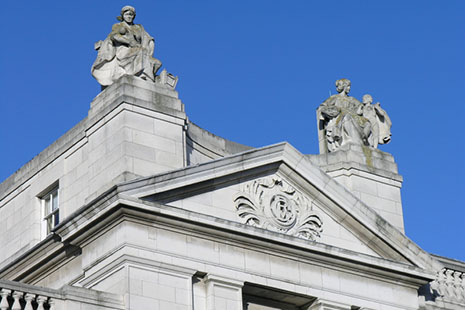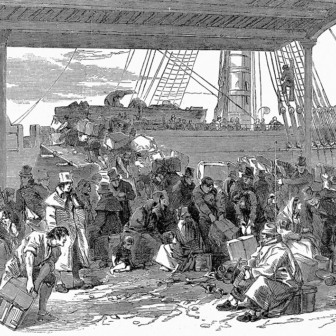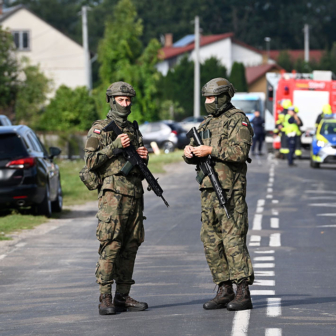NOBEL LAUREATE Paul Krugman recently described the US economy as “the Bernie Madoff of economies”: a success story that in reality masked “a fraud all along.” Some would say the same of the much-celebrated Celtic Tiger, where two decades of unprecedented economic growth have given way to an economic crisis of (almost) unprecedented proportions. That crisis is likely to reduce the size of GDP by a savage 8 per cent – or more – in 2009, with further declines in store during 2010 and 2011.
Yet the Bernie Madoff analogy does not quite fit, because much of the progress achieved in Ireland since the late 1980s represented genuine policy-driven movement towards to the European norm. The improvements in wellbeing were real and solidly based, and there is surely no question now of returning to the status quo ante. The shift from relative backwardness during the Celtic Tiger era, which came to an end in the early 2000s, led to a trebling of output per head. In 1985 per capita GDP was less than two-thirds of the European average; two decades later it was 130 per cent of the European average. In 2005 Irish GNP per head (a better measure of Irish performance given the significant repatriation of profits by foreign-owned multinationals) was 110 per cent of European GDP per head.
The rise in material living standards was accompanied by significant improvements in life expectancy at all ages. It was achieved without any notable increase in income inequality. And the population grew: between 1981 and 2006 it rose from 3.4 million to 4.2 million, much faster than in neighbouring Northern Ireland, and faster than anywhere else in Europe. That growth was fuelled in large part by immigration, and an ensuing increase in the birth rate. Ireland, for centuries a nation of emigrants, became a magnet for immigrants. Many came from the EU accession states of Poland, Lithuania and Latvia, but tens of thousands came from much farther afield. By 2006 one Irish resident in ten was foreign-born.
The success of the Celtic Tiger – or, what the macroeconomists Patrick Honohan and Brendan Walsh have more appropriately dubbed the Irish Hare – attracted considerable attention among foreign observers and governments, and a raft of publications lauding Irish achievements. The former economic tortoise was now (to quote the Economist magazine) “the shining light of Europe,” and its mix of social partnership, outward-looking policies, improvements in human capital and low taxes was to be emulated and replicated.
On the eve of the Celtic Tiger years, one in five of the labour force was unemployed. By 2004–06 the unemployment rate had reached a low of 4.4 per cent. Unemployment has been rising since, though slowly before mid-2008; it now stands at about 11 per cent. And as the economy continues to shrink, further increases in unemployment are inevitable. The contraction has also resulted in a big reduction in net immigration, from 67,300 in the year ending April 2007 to 38,500 a year later. Some pundits are predicting that net immigration will turn to net emigration over the next twelve months.
WHY THE REVERSAL in fortune? Although few noticed it at the time, things began to go awry in Ireland early in the new millennium, long before the global recession. Instead of accepting that the growth rates achieved in the 1990s were not meant to last, policy-makers and the banking sector encouraged an unsustainable expansion based largely on construction. Rising real incomes, low interest rates, immigration and an expectation that prices would continue to rise indefinitely – all of these factors buoyed the demand for housing. Lending institutions almost threw money at borrowers: before the housing bubble burst in 2007 house-buyers were borrowing up to eight or ten times their annual earnings. The rich speculated heavily in property investments, both at home and abroad. The flurry prompted builders who had grown rich in the Tiger years to overreach themselves, buying land and developing sites at increasingly unrealistic prices. The most famous example is the property tycoon Sean Dunne, who paid €380 million ($A700 million) for a three-hectare site in Dublin 4 in 2005 on a speculation that he would obtain planning permission to build a controversial complex of high density, high-rise buildings. In January 2009 Dunne’s site was still undeveloped, and he candidly revealed that “if the banking crisis continues I could be considered insolvent.”
Nearly one hundred thousand housing units were built in 2006. By then the construction sector was employing one worker in seven and accounting for almost one-fifth of GDP. The collapse has been quite drastic. House prices, which peaked in 2007, have fallen by a quarter by the northern spring of 2009. By then the construction sector was providing one third fewer jobs than three years earlier, with further job losses in prospect.
Some features of the Irish story are common currency, particularly the part played by financial institutions and their over-borrowed clients. Ironically, in the past Irish banks were often accused of being unduly risk-averse. Over the past decade or so a regime of loose regulation by both the central bank and the financial regulator (who resigned in February 2009) prompted banks to over-leverage by borrowing in order to make risky loans to the construction sector. As in Britain and the United States, bankers shed their traditional caution. No financial institution was immune, but one, Anglo-Irish Bank, was rescued through nationalisation in January 2009, and another, the Irish Nationwide Building Society, is generally considered to be in deep trouble. In the case of Anglo-Irish, currently under investigation by Ireland’s fraud squad, insider lending and dubious attempts to maintain share value were ingredients of its demise. Irish history buffs have noted that insider lending was also a key factor in two earlier sensational failures, those of the Tipperary Bank in 1856 and of the Munster Bank in 1885.
It is an ill wind that blows nobody good. The crisis has been good for the prestige of Irish academic macroeconomists, several of whom had been warning of impending trouble, and some of whom were criticised by then Taoiseach (prime minister) Bertie Ahern for “cribbing and moaning.” A feature of the new vogue for macroeconomics was the creation in January 2009 of www.irisheconomy.ie, which publishes brief commentaries on the unfolding crisis by Ireland’s leading academic economists. By mid-April its site-meter had already recorded one hundred thousand visits. The crisis has also produced Ireland’s own Dr Doom, the highly articulate and prescient Professor Morgan Kelly of University College Dublin. First to predict the implications of the housing bubble for the financial sector and the public finances, Kelly continues to predict a bleak future for the economy. For economists with a vested interest in riding the bubble it has been a different story. A few, now the laughing stocks of savvy Irish bloggers, have gone into hibernation. Some of their choicest pronouncements may be found in former insider Derek Brawn’s just-published Ireland’s House Party: What the Estate Agents Don’t Want You to Know.
SO IS THERE anything different about Ireland’s predicament? The answer is the colossal budget deficit, which is set to exceed 10 per cent in the current year, making it the worst in the Eurozone by a considerable margin. While the boom lasted, government revenue was extremely buoyant, but now the bleak fiscal outlook has led both Standard & Poor’s and Fitch’s analysts to downgrade Ireland’s AAA credit rating to AA+. This latest step may compound the government’s fiscal woes, since it is likely to increase the cost of borrowing. Escalating costs over the last decade or so are an added complication for an economy so dependent on exports and inward investment.
The worst fear is that the parlous state of the public finances will eventually deter investors in sovereign debt from lending further to the Irish government. Such an eventually, dubbed “sudden stop” in the macroeconomic literature, is almost too appalling to bear thinking about. In Morgan Kelly’s mordant prose, “it’s not about the property developers and the banks anymore – it is about the survival of Ireland.”
On the positive side, many commentators believed that last week’s emergency budget got the trade-off between cutting the deficit and further reducing economic growth just about right. It will not be enough to restore Ireland’s economic reputation, but it may help. Prior to the budget, politicians of most hues had been engaging in a softening up process about the pain they would inflict. The public in general was prepared for the tax hikes and public expenditure cuts – measures that would have been unimaginable a few years ago – which include further levies on all incomes and radical cutbacks in public investment projects. That there is more in store, including likely cuts in entitlements to social welfare, the reintroduction of tertiary education fees, and a broadening of the tax base, is common knowledge.
Despite organising some mass protests, public sector workers and their trade union representatives have become reconciled to severe cutbacks in real after-tax income. Moreover, the private sector labour market has demonstrated considerable flexibility in recent months: a survey in late March found that most firms had introduced pay freezes or pay cuts, and that the average pay decrease was 13 per cent. Given the choice, workers clearly prefer job security in the short term to pay cuts. Such adjustments just may help restore some of Ireland’s lost competitiveness. But no economy is an island, even an island economy. Ireland’s fate also depends on recovery elsewhere, particularly in the EU and the US. In sum, although significant cuts in living standards are inevitable, this does not mean all the gains made since the 1980s must be sacrificed. •




